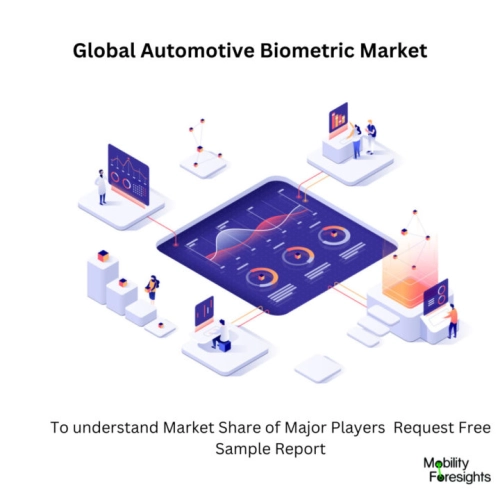
- Get in Touch with Us

Last Updated: Apr 25, 2025 | Study Period: 2023-2030
The employment of biometric authentication and identification systems in vehicles is referred to as automotive biometric technology. Biometrics is the use of distinctive physical or behavioral traits of people to confirm their identity.
A more seamless and convenient user experience is delivered by integrating biometric technology in automobile applications, which also adds an extra degree of protection and personalisation.
Autobiometric technology has advantages in terms of better safety, personalized driving experiences, and security.It can make the driving experience for the driver more comfortable and user-friendly by detecting the driver and adjusting car settings accordingly.
Heart rate monitoring is a feature of several cutting-edge vehicle systems that can identify indicators of stress or exhaustion in the driver. For safety reasons, this information can be utilized to send out notifications or take preventive action.
The security and privacy of the biometric data gathered by these devices must be guaranteed, though. To prevent unauthorized access to and improper use of sensitive biometric data, manufacturers must put in place effective data protection procedures.
To authenticate the driver, facial recognition technologies record and examine facial features. The driver's face can be recognized by this technology, which can then tailor settings like seat position, mirror angles, and entertainment preferences.
Automotive biometric systems are projected to become more common and sophisticated as technology develops, significantly enhancing user safety and the driving experience.

The Global automotive biometric market accounted for $XX Billion in 2022 and is anticipated to reach $XX Billion by 2030, registering a CAGR of XX% from 2023 to 2030.
In order to determine whether a motorist is in a serious physical state, Mitsubishi Electric has created a new system that uses a contactless motorist Monitoring System (DMS) camera to gather biometric data such as blood pressure and pulse.
Mitsubishi introduces Genesis facial recognition and health monitoring. The DMS has already been employed by Mitsubishi to identify tiredness and driver distraction. According to a press release from the firm, the new system estimates biometric data using Mitsubishi Electric's in-house AI and Maisart AI technology.
A new open-source software protocol called uProtocol has been created by General Motors, and it intends to connect automotive services and apps from various manufacturers.
The protocol can reduce the requirement for specialized in-car software and walled gardens by making software faster to develop and simpler to use across a variety of automotive and other devices.
The action is crucial since GM is getting ready to roll out its Ultifi software platform across all of its vehicles. According to the business, Ultifi can be used to run a variety of applications, from weather apps to in-car cameras for facial recognition.
| Sl no | Topic |
| 1 | Market Segmentation |
| 2 | Scope of the report |
| 3 | Abbreviations |
| 4 | Research Methodology |
| 5 | Executive Summary |
| 6 | Introduction |
| 7 | Insights from Industry stakeholders |
| 8 | Cost breakdown of Product by sub-components and average profit margin |
| 9 | Disruptive innovation in the Industry |
| 10 | Technology trends in the Industry |
| 11 | Consumer trends in the industry |
| 12 | Recent Production Milestones |
| 13 | Component Manufacturing in US, EU and China |
| 14 | COVID-19 impact on overall market |
| 15 | COVID-19 impact on Production of components |
| 16 | COVID-19 impact on Point of sale |
| 17 | Market Segmentation, Dynamics and Forecast by Geography, 2023-2030 |
| 18 | Market Segmentation, Dynamics and Forecast by Product Type, 2023-2030 |
| 19 | Market Segmentation, Dynamics and Forecast by Application, 2023-2030 |
| 20 | Market Segmentation, Dynamics and Forecast by End use, 2023-2030 |
| 21 | Product installation rate by OEM, 2023 |
| 22 | Incline/Decline in Average B-2-B selling price in past 5 years |
| 23 | Competition from substitute products |
| 24 | Gross margin and average profitability of suppliers |
| 25 | New product development in past 12 months |
| 26 | M&A in past 12 months |
| 27 | Growth strategy of leading players |
| 28 | Market share of vendors, 2023 |
| 29 | Company Profiles |
| 30 | Unmet needs and opportunity for new suppliers |
| 31 | Conclusion |
| 32 | Appendix |